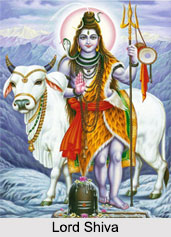 Shiva Aarti is an effort of praising and worshipping the revering Lord Shiva with its entire religiosity. Shiva Aarti is done on the fortunate occasion of "Mahashivratri" to pray for the divine blessings of Lord Shiva. Lord Shiva is one of the Hindu Trinity, comprising Lord Brahma, Lord Vishnu and Lord Maheshwara (Lord Shiva). He is thought to be responsible for the maintenance of life cycle. He is the only God who is in deep meditation for eternity and totally absorbed in contemplation in his abode, the Kailasa mountain of Himalayas.
Shiva Aarti is an effort of praising and worshipping the revering Lord Shiva with its entire religiosity. Shiva Aarti is done on the fortunate occasion of "Mahashivratri" to pray for the divine blessings of Lord Shiva. Lord Shiva is one of the Hindu Trinity, comprising Lord Brahma, Lord Vishnu and Lord Maheshwara (Lord Shiva). He is thought to be responsible for the maintenance of life cycle. He is the only God who is in deep meditation for eternity and totally absorbed in contemplation in his abode, the Kailasa mountain of Himalayas.
Legends of Lord Shiva
Lord Shiva is worshipped as a `Lingam` so as to imagine him as most basic and formless divine entity. He is commonly portrayed as an ascetic with a serpent around his neck, `Vibhuti` or sacred ash adoring his face, bare body covered with only a tiger skin, a "Trishul" or trident on his one hand, a `Kamandalu` (sacred container of holy water) and a `Damaru`(small drum) on his other hand. Lord Shiva wears garlands of Rudraksha, forest flowers and skulls. Lord Shiva"s forehead glistens with moonlight which it holds and smeared with sandal-paste and musk. His body is attired in white with yellow silken clothes and tiger skin. Lord Shiva is accompanied by troops of goblins, Gods like Brahma and divine prophets like Sankara. Lord brings joy to all, destroy the distress and sustain the whole world. Lord Brahma, Lord Vishnu and Lord Maheshwara are three individual gods, but all three of them are combined in a single sacred mantra `Om`.
Significance of Shiva Aarti
The expression "arti" refers to the prayer sung in honour of the God. It is usually performed and sung after the prayers. It is done to please the celestial Lord. It involves waving the lighted wicks in front of the sacred image of the God.
By doing aarti, the devotee can rectify any mistakes made throughout the process of puja. After the practice, the lighted wicks are conceded around to accept the blessings. Devotees take the light into them and therefore feel enlivened, blessed and confined. If daily Shiva Aarti is recited at the time of puja, it is believed that Lord Shiva provides the special blessings. It is also said that this aarti makes Lord Shiva happy and in return, Lord Shiva fills his or her life with happiness and affluence.
Hymn of Shiva Aarti
The Shiva Aarti is as follows:
Jai Shiv onkara, Prabhu jai Shiv onkara
Brahma Vishnu Sadashiv ardhangi dhara, Om
Har Har Mahadev...
Ekanan, chaturanan, panchanan raje,
Hansasan GarudaSan Vrishvahan saje, Om Har
Har Mahadev...
Do bhuj, charu chaturbhui dashmukh ati sohe
Tinon rup nirakhte tribhuvan janmohe, Om Har
Har Mahadev...
Akshyamala banamala mundmal dhari
Chandan mrigmad sohai, bhale shubhkari, Om
Har Har Mahadev...
Shvetambar Pitambar Bagambar ange,
Brahmadik Sankadik Pretadik sange, Om Har
Har Mahadev...
Kar madhye kamandalu au trishul bhari,
Sukhkari dukhahari jagpalankari, Om Har Har
Mahadev...
Brahma Vishnu Sadashiv janat aviveka,
Pranavakshar men shobhit ye tinon eka, Om
Har Har Mahadev...
Trigun svami ki arti jo koi nar gave
Kahat Shivanand svami man vanchhit phal pave.
By performing the sanctified Shiva Aarti, with the offerings of flowers, fruits, and foods, the devotee tries to create a connection with Lord Shiva through his or her emotions and senses.









